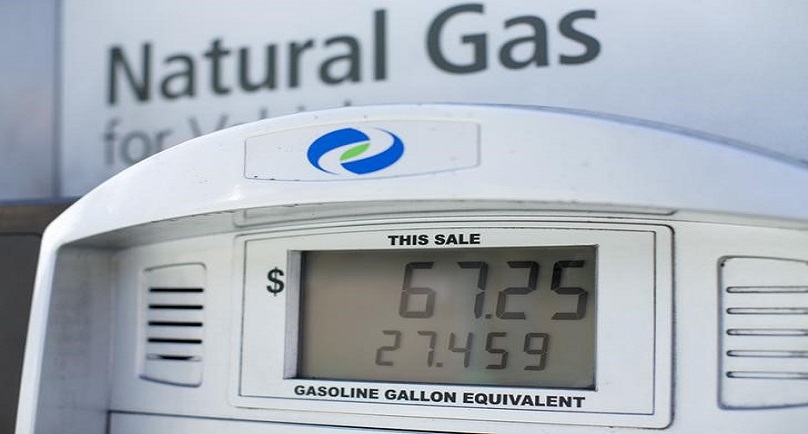Image: The price in relation to gallons of gas is displayed on a pump at a natural gas station in San Diego, California November 3, 2015. REUTERS/Mike Blake
By Scott DiSavino
NEW YORK (Reuters) – Last year looks like it was an unwelcome watershed for the embattled U.S. coal industry.
Power companies in 2015 for the first time may have burned more natural gas than coal to generate electricity, according to analysts who attribute it to the cheapest gas prices in 16 years and a record number of coal-fired plants retired from service because of the high cost of meeting environmental regulations.
Data from the U.S. Energy Information Administration showed that power plants used more gas than coal to produce electricity in five of the first 10 months of 2015, including the last four months data was available – July, August, September and October.
While EIA does not forecast that gas produced more electricity than coal in 2015, some analysts conclude it did because gas in November and December traded at the lowest levels for the entire year, prompting more substitution in what was already an unrivaled year for coal-to-gas switching.
Coal has been the primary source of fuel for U.S. power plants for the last century, but its use has been declining since peaking in 2007, which is expected to continue as the federal government imposes rules to limit carbon emissions.
EIA said gas produced a record high 37 million megawatt hours per day of electricity on average during the first ten months of 2015. Coal, meanwhile, produced about 39 MWh per day. One megawatt is enough to power about 1,000 U.S. homes.
By December the price of gas had plumbed $1.92 per million British thermal units, the lowest level since 1998.
EIA does not yet have final figures for November and December 2015, but consultancy PIRA Energy Group said its preliminary estimates showed gas topped coal in both months.
“That had a lot to do with the collapse of gas prices during the last two months of 2015 due primarily to weak heating demand,” said Greg Shuttlesworth, executive director natural gas at PIRA.
Thomson Reuters Analytics estimated economic coal-to-gas switching in November and December averaged 8.7 billion cubic feet of gas per day versus 6.1 bcfd for first 10 months of 2015.
“It’s likely the power sector produced more electricity with gas than coal in 2015. But rather than focus on which fuel generated the most power last year, it’s amazing enough that they are close to equal,” said Chris Kostas, senior power and gas analyst at Energy Security Analysis Inc (ESAI) in Massachusetts.
COAL IN DECLINE
Ten years ago, coal produced 50 percent of the nation’s power supply, while gas accounted for just 19 percent. Now, both fuel about 33 percent, according federal energy data.
The next biggest sources of power production last year were nuclear, at 19 percent, and non-hydro renewables, such as wind and solar, at 6 percent, EIA said.
As part of his effort to fight climate change, President Barack Obama last week ordered a pause on issuing new coal mining leases on federal land, which account for about 40 percent of U.S. coal production.
Gas fuel however is not without controversy. Production from shale formations using horizontal drilling and hydraulic fracturing, which provided much of the growth in output over the past decade, has contaminated some waterways and raised earthquake concerns.
The power sector consumed a record 26.4 bcf of gas per day on average last year, according to Thomson Reuters Analytics. Coal used to generate power is expected to have fallen 11 percent from 2014 to 754 million short tons, its lowest level since 1988, according to federal data.
It was not supposed to be that way. EIA in April 2015 forecast in its Annual Energy Outlook that coal would remain the nation’s dominant fuel for power generation until at least 2040.
The coal industry had been battered in recent years by competition from cheap gas and clean-air regulations that have raised costs for burning the dirty black rock.
Last week, Arch Coal Inc, the nation’s second biggest coal company, filed for bankruptcy – the latest mining company to seek protection from creditors in the current downturn.
“The trend in favor of gas is here to stay. Generators are adding more gas plants while retiring older coal plants,” said Kostas.
In 2015, U.S. power companies retired over 15,000 MW of coal plants, as inexpensive gas lowered what they could charge for electricity and made it uneconomic to upgrade coal plants to meet stricter federal environmental rules.
(Reporting by Scott DiSavino; Editing by Alden Bentley)
Copyright 2015 Thomson Reuters. Click for Restrictions.


